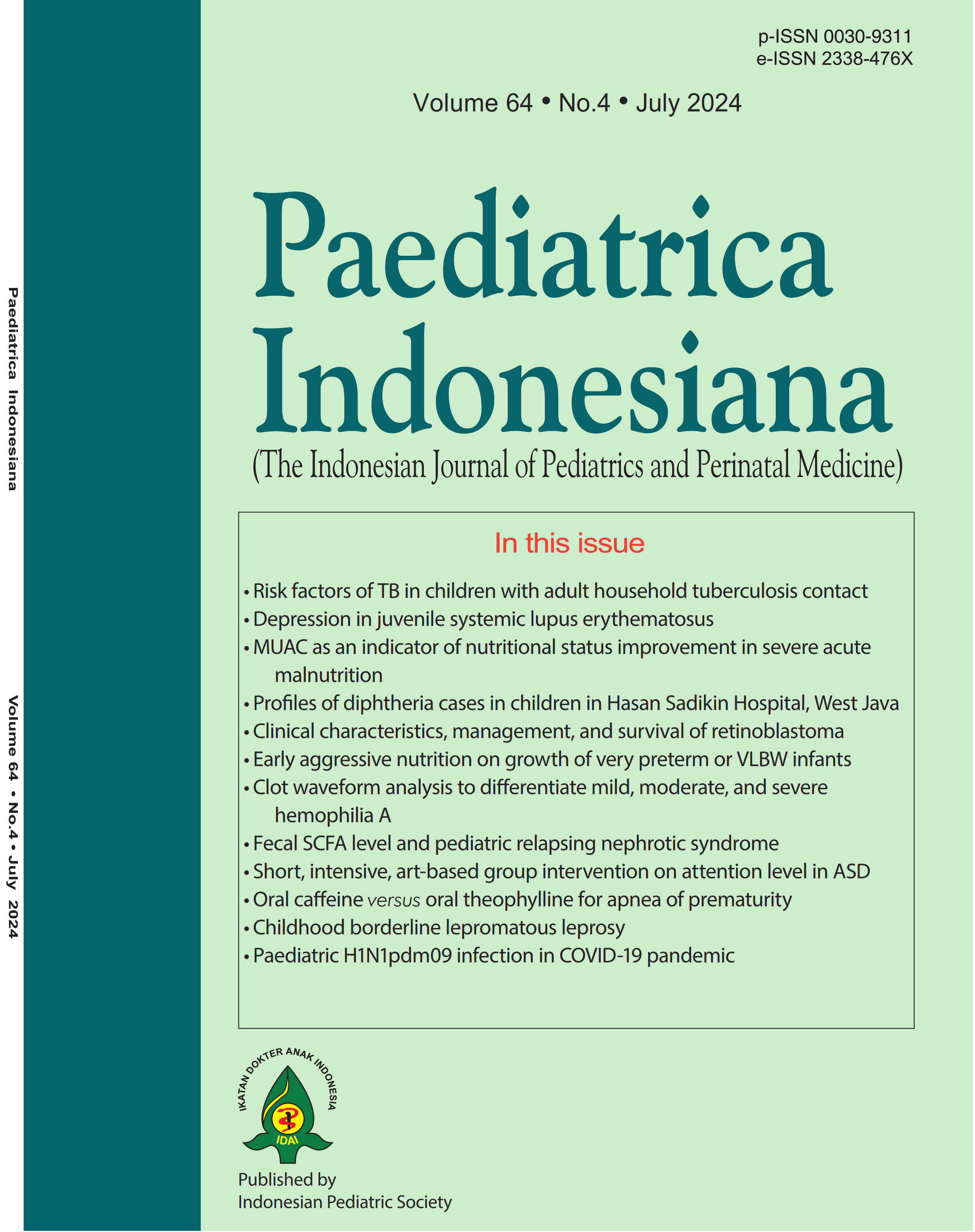Risk factors of tuberculosis in children with adult household tuberculosis contact
Abstract
Background Since children are more likely than adults to become infected with Mycobacterium tuberculosis or suffer from tuberculosis (TB), it is important to identify the risk factors of TB in children with adult household TB contacts.
Objective To identify the risk factors of TB in children with adult household TB contacts. Methods This cross-sectional study was conducted at the Pediatric Respirology Inpatient Ward and Outpatient Clinic at Dr. Soetomo Hospital, Surabaya, Indonesia, using medical records of hospitalized patients from 2010 to 2018. Patients were children below 18 years of age who had a history of adult TB household contact(s). We analyzed age at TB diagnosis, nutritional status, BCG vaccination status, and HIV status as possible risk factors of TB.
Results A total of 367 children with adult household TB contacts were included in our study. Age of <5 years (OR 8.38; 95%CI 3.78 to 18.21; P<0.001), severe malnutrition (OR 8.88; 95%CI 1.19 to 66.27, P<0.05), absence of BCG scar (OR 2.96; 95%CI 1.32 to 6.62, P<0.05), and positive HIV status (OR 6.72; 95%CI 1.72-38.49, P<0.05) were risk factors for contracting active TB.
Conclusion Age of <5 years, severe malnutrition, absence of BCG scar, and positive HIV status are significant risk factors for active TB in children with adult household TB contacts.
References
2. Martinez L, Shen Y, Mupere E, Kizza A, Hill PC, Whalen CC. Transmission of Mycobacterium tuberculosis in households and the community: a systematic review and meta-analysis. Am J Epidemiol. 2017;185:1327–39. DOI: https://doi.org/10.1093/aje/kwx025.
3. Franco JVA, Bongaerts B, Metzendorf MI, Risso A, Guo Y, Pena Silva L, et al. Undernutrition as a risk factor for tuberculosis disease. Cochrane Database Syst Rev. Epub ahead of print 2024. DOI: https://doi.org/10.1002/14651858.CD015890.pub2.
4. Singh M, Mynak ML, Kumar L, Mathew JL, Jindal SK. Prevalence and risk factors for transmission of infection among children in household contact with adults having pulmonary tuberculosis. Arch Dis Child. 2005; 90: 624. DOI: https://doi.org/10.1136/adc.2003.044255.
5. Development and Research Department, Ministry of Health of The Republic of Indonesia. Basic Health Research. Ministry of Health of Indonesia. 2018. [cited 2024 July 7]. Available from: https://kesmas.kemkes.go.id/assets/upload/dir_519d41d8cd98f00/files/Hasil-riskesdas-2018_1274.pdf.
6. Hamada Y, Glasziou P, Sismanidis C, Getahun H. Prevention of tuberculosis in household members: estimates of children eligible for treatment. Bull World Health Organ. 2019;97:534-547D. DOI: https://doi.org/10.2471/BLT.18.218651.
7. Shaikh N, Pelzer PT, Thysen SM, Roy P, Harris RC, White RG. Impact of COVID-19 Disruptions on global BCG coverage and paediatric TB mortality: a modelling study. Vaccines. 2021;9:1228. DOI: https://doi.org/10.3390/vaccines9111228.
8. World Health Organization. Weight-for-length/height. 2024. [cited 2024 July 7]. Available from: https://www.who.int/tools/child-growth-standards/standards/weight-for-length-height.
9. Centers for Disease Control and Prevention. Z-score Data Files. 2009. [cited 2024 July 7] Available from: https://www.cdc.gov/growthcharts/zscore.htm.
10. Ghanaie RM, Karimi A, Azimi L, James S, Nasehi M, Mishkar AP, et al. Diagnosis of latent tuberculosis infection among pediatric household contacts of Iranian tuberculosis cases using tuberculin skin test, IFN-? release assay and IFN-?-induced protein-10. BMC Pediatr. 2021;21:76. DOI: https://doi.org/10.1186/s12887-021-02524-3.
11. Vanden Driessche K, Persson A, Marais BJ, Fink PJ, Urdahl KB. Immune vulnerability of infants to tuberculosis. Clin Dev Immunol. 2013:781320. DOI: https://doi.org/10.1155/2013/781320.
12. Soares AP, Kwong Chung CKC, Choice T, Hughes EJ, Jacobs G, van Rensburg EJ, et al. Longitudinal changes in CD4+ T-cell memory responses induced by BCG vaccination of newborns. J Infect Dis. 2013;207:1084–94. DOI: https://doi.org/10.1093/infdis/jis941.
13. Jubulis J, Kinikar A, Ithape M, Khandave M, Dixit S, Hotalkar S, et al. Modifiable risk factors associated with tuberculosis disease in children in Pune, India. Int J Tuberc Lung Dis. 2014;18:198–204. DOI: https://doi.org/10.5588/ijtld.13.0314.
14. Cintron C, Narasimhan PB, Locks L, Babu S, Sinha P, Rajkumari N, et al. Tuberculosis—Learning the Impact of Nutrition (TB LION): protocol for an interventional study to decrease TB risk in household contacts. BMC Infect Dis. 2021;21:1058. DOI: https://doi.org/10.1186/s12879-021-06734-z.
15. Chandrasekaran P, Saravanan N, Bethunaickan R, Tripathy S. Malnutrition: modulator of immune responses in tuberculosis. Front Immunol. 2017;8:1316. DOI: https://doi.org/10.3389/fimmu.2017.01316.
16. Attah CJ, Oguche S, Egah D, Ishaya TN, Banwat M, Adgidzi AG. Risk factors associated with paediatric tuberculosis in an endemic setting. Alexandria J Med. 2018;54:403–9. DOI: https://doi.org/10.1016/j.ajme.2018.05.002.
17. Dawit Z, Abebe S, Dessu S, Mesele M, Sahile S, Ajema D. Incidence and predictors of mortality among children co-infected with tuberculosis and human immunodeficiency virus at public hospitals in Southern Ethiopia. PLoS One. 2021;16:e0253449. DOI: https://doi.org/10.1371/journal.pone.0253449.
18. Venturini E, Turkova A, Chiappini E, Galli L, de Martino M, Thorne C. Tuberculosis and HIV co-infection in children. BMC Infect Dis. 2014;14:S5. DOI: https://doi.org/10.1186/1471-2334-14-S1-S5.
19. Sonnenberg P, Glynn JR, Fielding K, Murray J, Godfrey?Faussett P, Shearer S. How soon after infection with HIV does the risk of tuberculosis start to increase? A retrospective cohort study in South African gold miners. J Infect Dis. 2005;191:150–8. DOI: https://doi.org/10.1086/426827.
20. Geldmacher C, Zumla A, Hoelscher M. Interaction between HIV and Mycobacterium tuberculosis: HIV-1-induced CD4 T-cell depletion and the development of active tuberculosis. Curr Opin HIV AIDS. 2012;7:268-75. DOI: https://doi.org/10.1097/COH.0b013e3283524e32.
21. Kay AW, Rabie H, Maleche-Obimbo E, Sekadde MP, Cotton MF, Mandalakas AM. HIV-associated tuberculosis in children and adolescents: evolving epidemiology, screening, prevention and management strategies. Pathogens. 2021;11:33. DOI: https://doi.org/10.3390/pathogens11010033.
Copyright (c) 2024 Retno Asih Setyoningrum, Rizky Arisanti Maharani, Rika Hapsari, Arda Pratama Putra Chafid

This work is licensed under a Creative Commons Attribution-NonCommercial-ShareAlike 4.0 International License.
Authors who publish with this journal agree to the following terms:
Authors retain copyright and grant the journal right of first publication with the work simultaneously licensed under a Creative Commons Attribution License that allows others to share the work with an acknowledgement of the work's authorship and initial publication in this journal.
Authors are able to enter into separate, additional contractual arrangements for the non-exclusive distribution of the journal's published version of the work (e.g., post it to an institutional repository or publish it in a book), with an acknowledgement of its initial publication in this journal.
Accepted 2024-08-02
Published 2024-08-02













